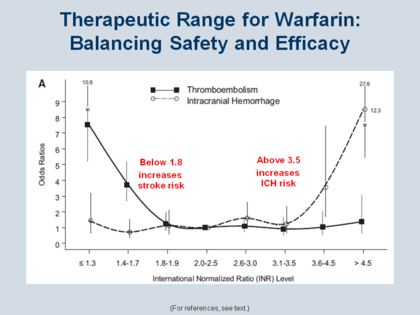
The prothrombin time is the time it takes plasma to clot after addition of tissue factor (obtained from animals). The INR is the ratio of a patient's prothrombin time to a normal (control) sample, raised to the power of the ISI value for the control sample used.Ĭlick here for more details about the use of INR for warfarin monitoring. The ISI value indicates how the particular batch of tissue factor compares to an internationally standardized sample. The prothrombin ratio is the prothrombin time for a patient, divided by the result for control plasma.īecause of differences between different batches and manufacturers of tissue factor (it is a biologically obtained product), the INR was devised to standardise the results.Įach manufacturer gives an ISI (International Sensitivity Index) for any tissue factor they make. Some laboratories use a mechanical measurement, which eliminates interferences from lipemic and icteric samples. Tissue factor (also known as factor III or thromboplastin) is added, and the time the sample takes to clot is measured optically. If a tube is underfilled or overfilled with blood, the standardized dilution of 1.1 is no longer valid. So, all analysis takes this dilution into account by multiplying the result by 1.1 to account for the dilution. This dilution will cause a falsely long prothrombin time. Just as adding solvent to any solution will dilute it, adding liquid anticoagulant to blood will dilute it. For the prothrombin time test the appropriate sample is the blue top tube, or citrate tube, which is a liquid anticoagulant. This is because Vacutainer test tubes generally contain a powdered anticoagulant to prevent blood from clotting. For an accurate measurement the proportion of blood to citrate needs to be fixed many laboratories will not perform the assay if the tube is underfilled and contains a relatively high concentration of citrate. An excess of calcium is added (thereby reversing the effects of citrate), which enables the blood to clot again. The plasma is analyzed by a medical technologist on an automated instrument at 37☌, which takes a sample of the plasma. The blood is mixed, then centrifuged to separate blood cells from plasma. Citrate acts as an anticoagulant by binding the calcium in a sample. Blood is drawn into a test tube containing liquid citrate. The prothrombin time can be measured roughly on whole blood (which is done in neonates), but is more commonly measured from blood plasma. The INR became widely accepted worldwide, especially after endorsement by the World Health Organisation Causes of Elevated PT The INR was introduced in the early 1980s when it turned out that there was a large degree of variation between the various prothrombin time assays, a discrepancy mainly due to problems with the purity of the thromboplastin (tissue factor) concentrate. It aided in the identification of the anticoagulants dicumarol and warfarin, and was used subsequently as a measure of activity for warfarin when used therapeutically. The prothrombin time was discovered by Dr Armand Quick and colleagues in 1935, and a second method was published by Dr Paul Owren (also called the "p and p" or "prothrombin and proconvertin" method). It is used in conjunction with the activated partial thromboplastin time (aPTT) which measures the intrinsic pathway. PT measures factors II, V, VII, X and fibrinogen. The reference range for prothrombin time is usually around 12-15 seconds the normal range for the INR is 0.8-1.2. They are used to determine the clotting tendency of blood, in the measure of warfarin dosage, liver damage and vitamin K status. The prothrombin time (PT) and its derived measures of prothrombin ratio (PR) and international normalized ratio (INR) are measures of the extrinsic pathway of coagulation. Synonyms and keywords: International normalized ratio, INR, prothrombin ratio, PR, PT List of terms related to Prothrombin timeĮditor-In-Chief: C. Risk calculators and risk factors for Prothrombin timeĬauses & Risk Factors for Prothrombin time US National Guidelines Clearinghouse on Prothrombin timeĭirections to Hospitals Treating Prothrombin time

Ongoing Trials on Prothrombin time at Clinical Ĭlinical Trials on Prothrombin time at Google Articles on Prothrombin time in N Eng J Med, Lancet, BMJĬochrane Collaboration on Prothrombin time


 0 kommentar(er)
0 kommentar(er)
